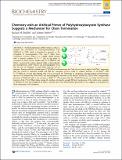| dc.contributor.author | Stubbe, JoAnne | |
| dc.contributor.author | Buckley, Rachael M. | |
| dc.date.accessioned | 2016-08-18T20:40:38Z | |
| dc.date.available | 2016-08-18T20:40:38Z | |
| dc.date.issued | 2015-03 | |
| dc.date.submitted | 2015-02 | |
| dc.identifier.issn | 0006-2960 | |
| dc.identifier.issn | 1520-4995 | |
| dc.identifier.uri | http://hdl.handle.net/1721.1/103958 | |
| dc.description.abstract | Polyhydroxybutyrate (PHB) synthases (PhaCs) catalyze the conversion of 3-(R)-hydroxybutyryl CoA (HBCoA) to PHB, which is deposited as granules in the cytoplasm of microorganisms. The class I PhaC from Caulobacter crescentus (PhaC[subscript Cc]) is a highly soluble protein with a turnover number of 75 s[superscript –1] and no lag phase in coenzyme A (CoA) release. Studies with [1-[superscript 14]C]HBCoA and PhaC[subscript Cc] monitored by sodium dodecyl sulfate–polyacrylamide gel electrophoresis (SDS–PAGE) and autoradiography reveal that the rate of elongation is much faster than the rate of initiation. Priming with the artificial primer [[superscript 3]H]sTCoA and monitoring for CoA release reveal a single CoA/PhaC, suggesting that the protein is uniformly loaded and that the elongation process could be studied. Reaction of sT-PhaC[subscript Cc] with [1-[superscript 14]C]HBCoA revealed that priming with sTCoA increased the uniformity of elongation, allowing distinct polymerization species to be observed by SDS–PAGE and autoradiography. However, in the absence of HBCoA, [3H]sT-PhaC unexpectedly generates [3H]sDCoA with a rate constant of 0.017 s[superscript –1]. We propose that the [[superscript 3]H]sDCoA forms via attack of CoA on the oxoester of the [[superscript 3]H]sT-PhaC chain, leaving the synthase attached to a single HB unit. Comparison of the relative rate constants of thiolysis by CoA and elongation by PhaC[subscript Cc], and the size of the PHB polymer generated in vivo, suggests a mechanism for chain termination and reinitiation. | en_US |
| dc.description.sponsorship | National Institutes of Health (U.S.) (NIH Grant GM49171) | en_US |
| dc.language.iso | en_US | |
| dc.publisher | American Chemical Society (ACS) | en_US |
| dc.relation.isversionof | http://dx.doi.org/10.1021/bi501405b | en_US |
| dc.rights | Article is made available in accordance with the publisher's policy and may be subject to US copyright law. Please refer to the publisher's site for terms of use. | en_US |
| dc.source | ACS | en_US |
| dc.title | Chemistry with an Artificial Primer of Polyhydroxybutyrate Synthase Suggests a Mechanism for Chain Termination | en_US |
| dc.type | Article | en_US |
| dc.identifier.citation | Rachael M. Buckley, and JoAnne Stubbe. "Chemistry with an Artificial Primer of Polyhydroxybutyrate Synthase Suggests a Mechanism for Chain Termination." Biochemistry 54:12 (2015), pp. 2117-2125. © 2015 American Chemical Society. | en_US |
| dc.contributor.department | Massachusetts Institute of Technology. Department of Biology | en_US |
| dc.contributor.department | Massachusetts Institute of Technology. Department of Chemistry | en_US |
| dc.contributor.mitauthor | Buckley, Rachael Marie | en_US |
| dc.contributor.mitauthor | Stubbe, JoAnne | en_US |
| dc.relation.journal | Biochemistry | en_US |
| dc.eprint.version | Final published version | en_US |
| dc.type.uri | http://purl.org/eprint/type/JournalArticle | en_US |
| eprint.status | http://purl.org/eprint/status/PeerReviewed | en_US |
| dspace.embargo.terms | N | en_US |
| dc.identifier.orcid | https://orcid.org/0000-0001-8076-4489 | |
| mit.license | PUBLISHER_POLICY | en_US |
| mit.metadata.status | Complete | |
